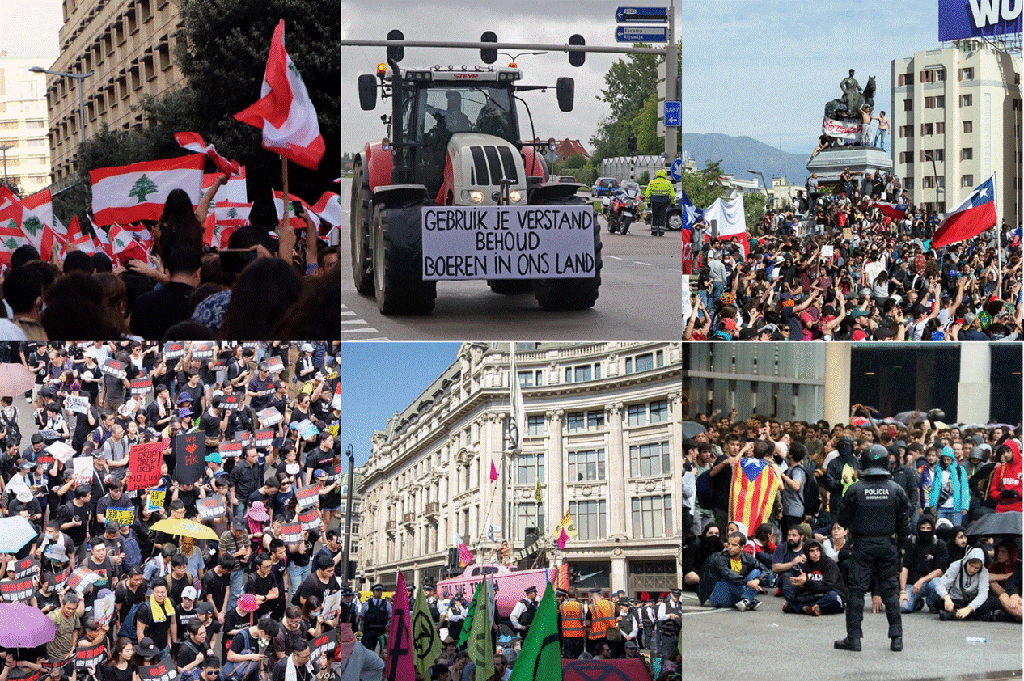Blog
Recursive Waves
Ann Rigney:

In the last weeks the headlines have been full of protesters. Each day seems to introduce a new flashpoint. Thousands of Dutch farmers on tractors resisting government measures to reduce nitrogen emissions while thousands of their fellow citizens perform lie-ins in the name of Extinction Rebellion. A massive crowd marching on Westminster waving EU flags to demand a second referendum on Brexit. Huge anti-government demonstrations filling the streets of Beirut, Addis Ababa, and Baghdad to demand economic and political changes. Images of burning barricades and cars in Barcelona as people vent their anger at the severity of the jail sentences handed down to the Catalan politicians who had been behind the region’s abortive declaration of independence in 2017. Across Latin America too – in Chile, in Bolivia, in Ecuador, in Argentina – people have been taking to the streets en masse in protest against government corruption and social inequality. And all the time the Hong Kong protests have continued, albeit at a slower pace after 21 weeks, doggedly inventing ever new ways to convey their message and wrongfoot the police.
The range of causes is huge. The range of tactics too, as demonstrators come up with new methods to stake their claims, often borrowing from each other: when the Catalans, for instance, blocked access to the airport they were taking their lead from Hong Kong. And behind the many, often spectacular images of protest there is always the possibility of violence — and, too often, its reality. In the month of October more than 200 demonstrators have been killed in Iraq; on 26 October alone, 19 protesters died in Chile. It seems as if we are dealing with a global wave of protest whose outcome is unpredictable.
When we started the ReAct project we had no idea this was going to happen. ReAct was above all inspired by an earlier wave of protests: the Arab Spring, the various Occupy and Anti-austerity movements, and Gezi Park. By now these lie almost a decade in the past. In the 24/7 news cycle, a decade is a long time. As the news flows ever faster, public attention keeps shifting to the latest, to the emergent, and to what is happening now. It seems as if demonstrations are like mayflies: here today and gone tomorrow.
This is not the case, however. When demonstrations disappear from the news, they turn into memory; into stories that are carried by words and images, in the form of memoirs and documentaries, but also in songs and slogans. This is where ReAct comes in. In ReAct we are trying to identify such traces, so as to understand better how people make sense of protest events, both in the short term and in the long term. How has the memory of earlier protests been kept alive and by whom? And how does this memory impact on later activists and shape their actions and their willingness to mobilise again – be this in five years time, ten years, or an entire generation later?
Despite the sense of crisis associated with protest waves, we have been discovering that social movements have a long cultural tail. Protesters in Gezi Park in 2013, for example, were still recalling the Paris Commune of 1871. How did the story of the Commune survive and how did it reach Turkey? One way to answer such questions is to study contemporary movements as they unfold and see how they invoke their predecessors. Another way is to look back and trace the afterlives of earlier generations of activists and other protest waves. This is the strategy within ReAct. We are trying to understand the unpredictable present by giving it a history. This means consciously stepping away to create a critical space for a long-term view, stretching back, not just to the protest wave of 10 years ago, but also to the 1960s, the 1870s and even beyond. The actors on stage keep changing, but the stories that mobilise them have deep roots in sometimes unexpected places.


